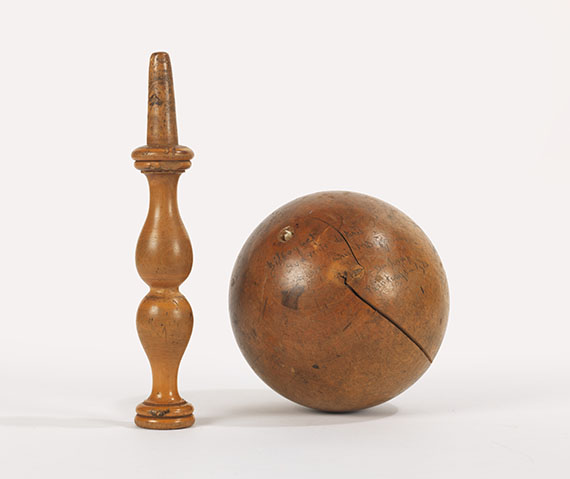Dictionary


Absolute Surrealism
In terms of styles, Surrealism can be divided into two different tendencies, Verist Surrealism or Naturalistic Surrealism with its almost photographic illusionism of fantastic worlds, which is often regarded as the "Surrealist" par excellence.
However, the beginning of Surrealism is marked by Absolute Surrealism, which is closer to its theoretic specifications and ideas. Absolute Surrealism originated from the idea that the unconscious had to be transferred to the work of art as direct as possible. Thus the unconscious in Absolute Surrealism was not only the subject depicted, but more a part of the process of depiction itself.
In this context, the method of depiction called "Cadavre Exquis" has to be mentioned, a method in which several artists make one drawing, each artist continued the work without knowing what his predecessor had drawn. This way amazing compositions were made, they disengaged the process of de-contextualization from any rationality. The techniques "écriture automatique" (automatic writing) and "dessin automatique" (automatic drawing), which seemed akin to esoteric practices of the early 20th century, were the initial point of the often almost non-representational compositions of Absolute Surrealism, which refer to the gestural tendencies of abstraction in a formal sense. Absolute Surrealism is often dominated by vegetable, organic forms in the sense of biomorph Abstraction. Absolute Surrealism is made comprehensible in works of, for instance, Jean (Hans) Arp (also in his sculptures), in the free line management of André Masson, in Max Ernst's techniques grattage or frottage, and also in works by Joan Miró or Yves Tanguy. As far as sculpting is concerned, Henry Moore is worthwhile mentioning, whose biomorphic-abstract works show impulses of Absolute Surrealism.
Around 1928, when André Breton feared that Absolute Surrealism could end in a plain Aestheticism, the turn to Veristic Surrealism took place.
In terms of styles, Surrealism can be divided into two different tendencies, Verist Surrealism or Naturalistic Surrealism with its almost photographic illusionism of fantastic worlds, which is often regarded as the "Surrealist" par excellence.
However, the beginning of Surrealism is marked by Absolute Surrealism, which is closer to its theoretic specifications and ideas. Absolute Surrealism originated from the idea that the unconscious had to be transferred to the work of art as direct as possible. Thus the unconscious in Absolute Surrealism was not only the subject depicted, but more a part of the process of depiction itself.
In this context, the method of depiction called "Cadavre Exquis" has to be mentioned, a method in which several artists make one drawing, each artist continued the work without knowing what his predecessor had drawn. This way amazing compositions were made, they disengaged the process of de-contextualization from any rationality. The techniques "écriture automatique" (automatic writing) and "dessin automatique" (automatic drawing), which seemed akin to esoteric practices of the early 20th century, were the initial point of the often almost non-representational compositions of Absolute Surrealism, which refer to the gestural tendencies of abstraction in a formal sense. Absolute Surrealism is often dominated by vegetable, organic forms in the sense of biomorph Abstraction. Absolute Surrealism is made comprehensible in works of, for instance, Jean (Hans) Arp (also in his sculptures), in the free line management of André Masson, in Max Ernst's techniques grattage or frottage, and also in works by Joan Miró or Yves Tanguy. As far as sculpting is concerned, Henry Moore is worthwhile mentioning, whose biomorphic-abstract works show impulses of Absolute Surrealism.
Around 1928, when André Breton feared that Absolute Surrealism could end in a plain Aestheticism, the turn to Veristic Surrealism took place.
Offers for Surrealism
Headquarters
Joseph-Wild-Str. 18
81829 Munich
Phone: +49 89 55 244-0
Fax: +49 89 55 244-177
info@kettererkunst.de
Louisa von Saucken / Undine Schleifer
Holstenwall 5
20355 Hamburg
Phone: +49 40 37 49 61-0
Fax: +49 40 37 49 61-66
infohamburg@kettererkunst.de
Dr. Simone Wiechers / Nane Schlage
Fasanenstr. 70
10719 Berlin
Phone: +49 30 88 67 53-63
Fax: +49 30 88 67 56-43
infoberlin@kettererkunst.de
Cordula Lichtenberg
Gertrudenstraße 24-28
50667 Cologne
Phone: +49 221 510 908-15
infokoeln@kettererkunst.de
Hessen
Rhineland-Palatinate
Miriam Heß
Phone: +49 62 21 58 80-038
Fax: +49 62 21 58 80-595
infoheidelberg@kettererkunst.de
We will inform you in time.




